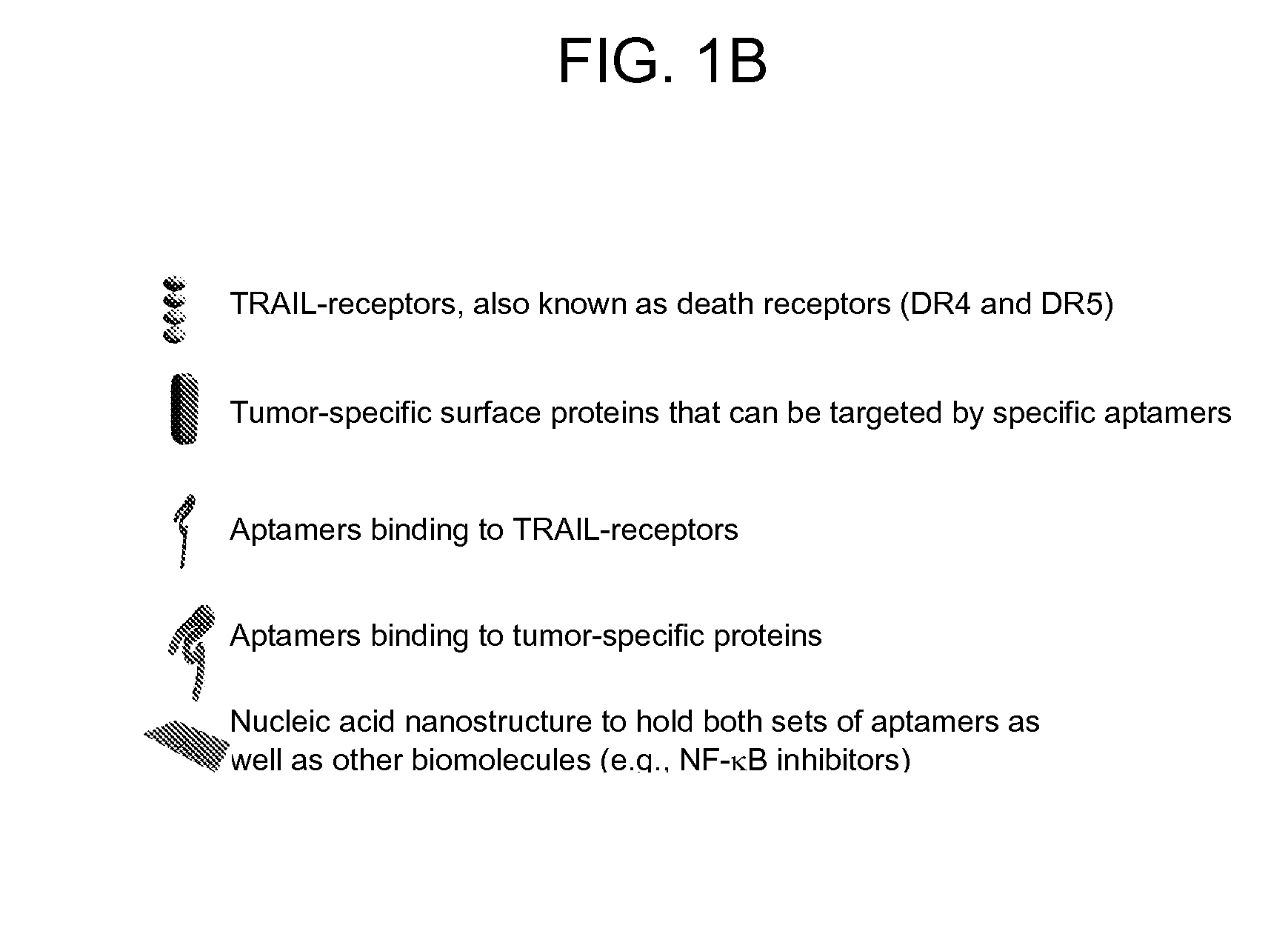Multifunctional aptamer-nucleic acid nanostructures for tumor-targeted killing
a nucleic acid nanostructure and multi-functional technology, applied in the field of nanotechnology, can solve the problems of systemic toxicity, ineffectiveness, and dampened prospects of recombinant trail anti-cancer therapy
- Summary
- Abstract
- Description
- Claims
- Application Information
AI Technical Summary
Benefits of technology
Problems solved by technology
Method used
Image
Examples
example 1
Selection of Aptamers
[0137]Aptamers having desirable binding affinity to a tumor antigen on B leukemia Ramos cells are selected from a random aptamer library. Because the Ramos cells express primarily TRAIL-R1, aptamers that specifically bind to TRAIL-R1 are also selected from the random aptamer library. Specifically, TRAIL-R1-Fc fusion protein (catalog No. D9438, Sigma, St. Louis, Mo.), as well as decoy receptors-Fc fusion proteins (catalog No. 630-TR-100, R & D Systems, Minneapolis, Minn.) are incubated with the aptamer library. Candidate aptamers having binding affinity to the TRAIL-R1-Fc fusion protein but not to the decoy receptor-Fc fusion proteins are identified by capillary electrophoresis. Aptamer-fusion protein complexes are detected by the retardation of migration rate in electrophoresis. Candidate aptamers are amplified by the SELEX procedure as known in the art and described in this application.
example 2
Construction of Bi-Specific Aptamer-Nucleic Acid Nanostructure for Tumor-Specific Killing
[0138]Although TRAIL-Rs are primarily expressed in tumor cells, they are also found present in normal cells and have been suggested to account for TRAIL-induced toxicity (Zheng et al., 2004, J Clin Invest 113:58-64). To achieve tumor-specific targeting, bi-specific aptamer-nucleic acid nanostructures containing tumor-specific aptamers and death receptor-specific aptamers on a DNA-nanostructure are generated. The aptamer M2 as previously reported that is specific to Ramos cells, and does not bind to T-cell leukemia cells has been reported (Shangguan et al., 2006, Proc Natl Acad Sci USA 103:11838-11843) (M2 aptamer: 5′-TAGGCAGTGGTTTGACGTCCGCATG TTGGGAATAGCCACGCCT-3′, SEQ ID NO:42). The tumor-specific aptamers M2 are assembled onto a DNA-nanostructure along with the death-inducible aptamers, in which various configurations will be constructed, in terms of position and copy numbers of aptamers, as w...
example 3
Aptamers Remained Stable Under Different Conditions
[0142]The stability of the dimeric aptamers was tested in this experiment. The dimeric B cell-specific aptamer M1, which consisted of monomeric aptamer M2, was incubated in the culture medium (1 mg / ml BSA in PBS) with or without human B cell lymphoma at different temperatures. After incubation, aptamers were recovered from the cell mixture by spinning down the cells. The supernatants were treated with phenol / chloroform to remove proteins, and the aptamers were precipitated by 95% ethanol. The recovered aptamer DNA was dissolved in H2O and separated by a native polyacrylamide gel (16%) to check the integrity of the aptamers-nanostructure.
[0143]As shown in FIG. 5, the integrity and levels of recovered aptamers were comparable under all conditions tested, including incubating with or without cells in the culture medium at 4° C., room temperature, and 37° C. Thus, this multimeric aptamer-DNA nanostructure was relatively stable in cell c...
PUM
| Property | Measurement | Unit |
|---|---|---|
| distance | aaaaa | aaaaa |
| distance | aaaaa | aaaaa |
| length | aaaaa | aaaaa |
Abstract
Description
Claims
Application Information
 Login to View More
Login to View More - R&D
- Intellectual Property
- Life Sciences
- Materials
- Tech Scout
- Unparalleled Data Quality
- Higher Quality Content
- 60% Fewer Hallucinations
Browse by: Latest US Patents, China's latest patents, Technical Efficacy Thesaurus, Application Domain, Technology Topic, Popular Technical Reports.
© 2025 PatSnap. All rights reserved.Legal|Privacy policy|Modern Slavery Act Transparency Statement|Sitemap|About US| Contact US: help@patsnap.com



